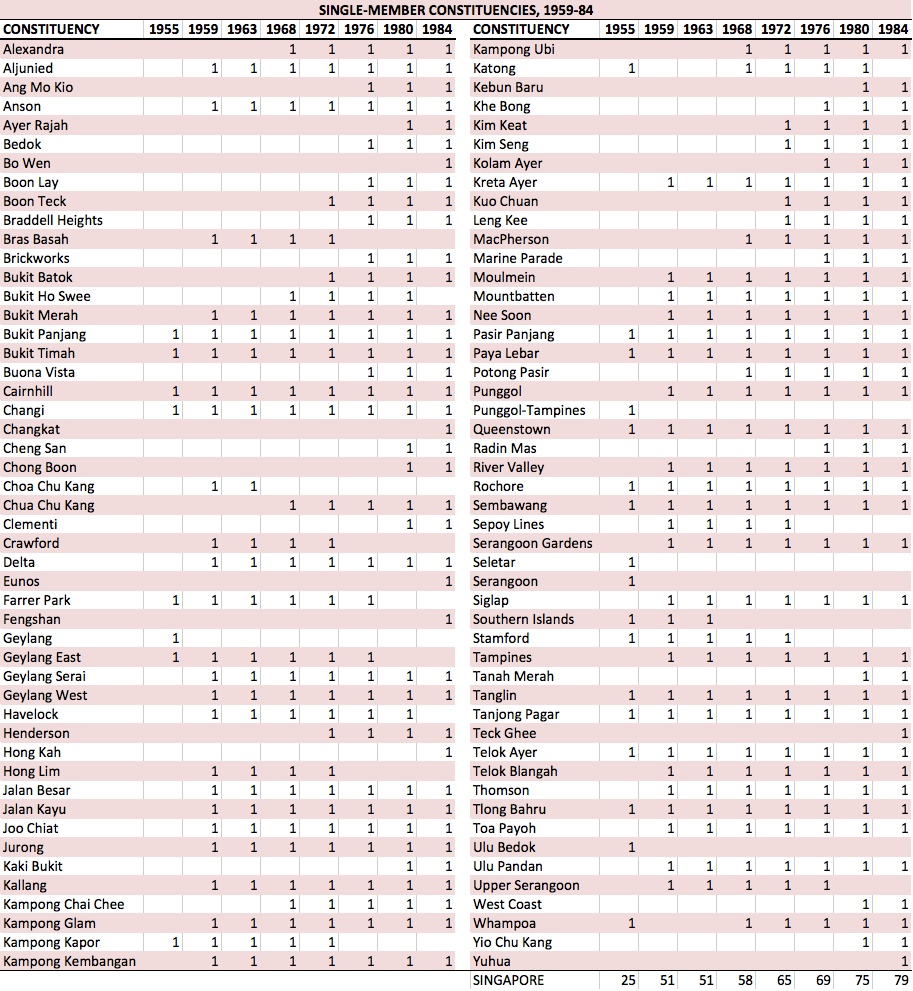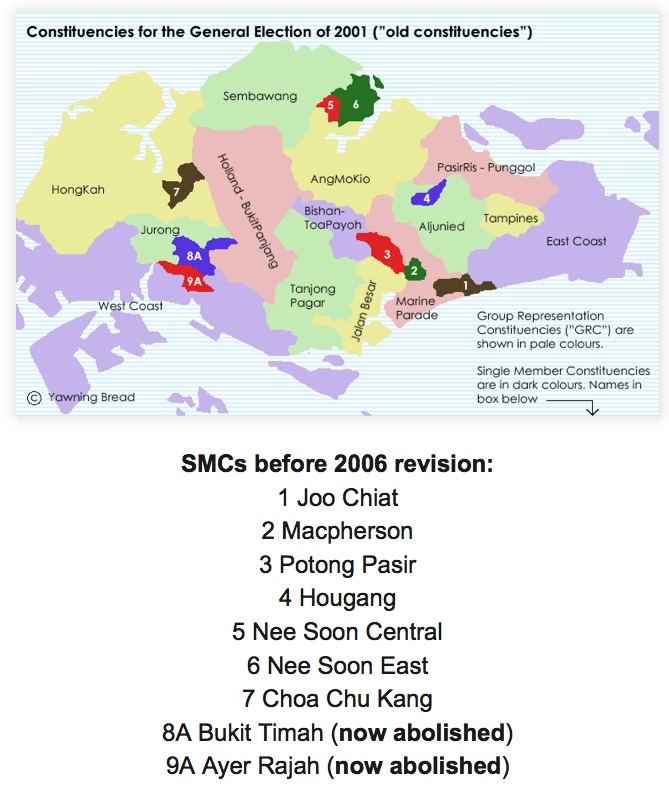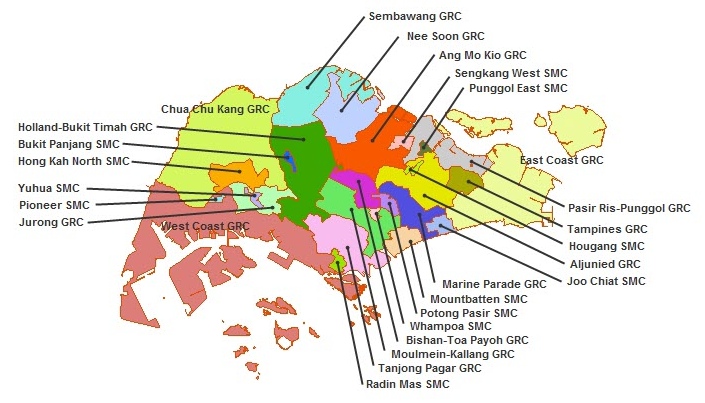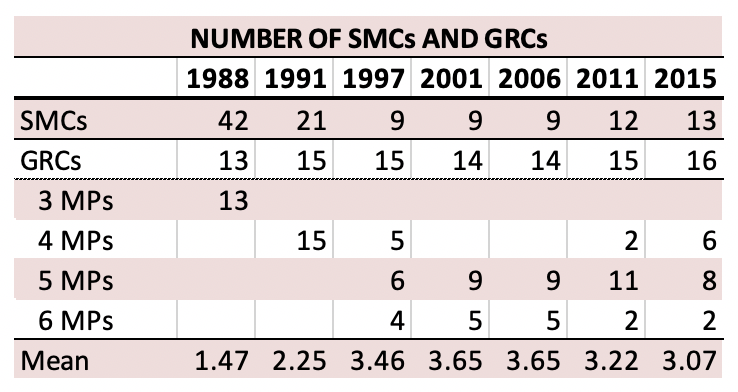Singapore’s legislature was called the Legislative Assembly while Singapore was a British colony and then briefly part of independent Malaysia from 1963 until 1965 before being renamed Parliament when Singapore became an independent country. Despite these changes, the Assembly and then Parliament were elected solely by the single-member plurality electoral system from 1955 through 1984. Though Singapore used the same basic electoral system during this period, the expansion in the legislature’s size along with changes in political status of the country result in the definition of multiple electoral systems:
Singapore 1 (1955): 25 seats (British colony).
Singapore 2 (1959-68): 51 seats in 1959 (British colony).
Singapore 3 (1963): 51 seats (Malaysia),
Singapore 4 (1968-76): 58 seats in 1968, 65 seats in 1972, 69 seats in 1976 (independent Singapore).
Singapore 5 (1980-84): 75 seats in 1980, 79 seats in 1984.
The following table shows the constituency names utilized during this period:
 Starting in 1988, Singapore began electing some MPs from multimember constituencies, known as Group Representation Constituencies (GRCs), as well as single-member constituencies (SMCs). In GRCs, voters must choose among closed lists. In other words, Singaporean voters must cast a ballot for a single party slate of candidates and cannot split votes among candidates of different parties or independent candidates.
Starting in 1988, Singapore began electing some MPs from multimember constituencies, known as Group Representation Constituencies (GRCs), as well as single-member constituencies (SMCs). In GRCs, voters must choose among closed lists. In other words, Singaporean voters must cast a ballot for a single party slate of candidates and cannot split votes among candidates of different parties or independent candidates.
In each GRC, parties must reserve at least one place on their list for the designated minority–either a Malay-Singaporean, or Indo-Singaporean (or another minority).
Additionally, starting in 1988, the President could nominate up to 6 Non-Constituency Members of Parliament (NCMPs) from among defeated opposition candidates. The maximum number of NCMPs increased to 9 in 2010. In 1990, the President also gained the right to choose up to 6 Nominated Members of Parliament (NMPs), increased to 9 in 1997. Neither NCMPs nor NMPs can vote on motions related to constitutional amendments, revenue or spending bills, or confidence in the Government.
The following table shows the number of SMCs and GRCs of different magnitudes from 1988 to 2015 as well as mean constituency magnitude.
The following table shows the name and magnitude of constituencies from 1988 to 2015:
Though Singapore used the same basic electoral system from 1988 onward, the expansion in the legislature’s size along with changes in mean magnitude result in the definition of multiple electoral systems.
Singapore 6 (1988): 81 seats. Additional MPs: 2 NCMPs (but 1 disqualified), 2 NMPs starting in November 1990. A new electoral system was defined because of the addition of GRCs for the first time.
Singapore 7 (1991): 81 seats (plus no NCMPs, 6 NMPs). A new electoral system was defined because of the significant increase in mean constituency magnitude from 1.47 to 2.25.
Singapore 8 (1997-): 83 seats (plus 1 NCMP, 9 NMPs) in 1997, 84 seats (plus 1 NCMP, 9 NMPs) in 2001 and 2006, 87 seats (plus 3 NCMPs, 9 NMPs) in 2011, 89 seats (plus 3 NCMPs, 9 NMPs) in 2015. A new electoral system was defined because of the significant increase in mean constituency magnitude from 2.25 to 3.46.
Singapore 2001 Constituencies Map
 Map Source: Singapore Election Watch.
Map Source: Singapore Election Watch.
Singapore 2006 Constituencies Map
Singapore 2011 Constituencies Map
 Map Source: Singapore Elections Department.
Map Source: Singapore Elections Department.

Source: Singapore Elections Department
Report of the Electoral Boundaries Review Committee, 2015
Parliamentary Elections Act, as amended through 2017
Sources: Singapore Elections Department; Jinshan Li and Jørgen Elklit, “The Singapore general election 1997: campaigning strategy, results, and analysis,” Electoral Studies 18(1999), 199-216; Hans Christoph Rieger, “Singapore” in Dieter Nohlen, Florian Grotz and Christof Hartmann, eds., Elections in Asia and the Pacific, Vol. II (New York: Oxford University Press 2001), 243-5; James Chin, “The general election in Singapore, May 2006,” Electoral Studies 26(2007), 703-7; Singapore Elections, http://www.singapore-elections.com/ (private unofficial archive).



